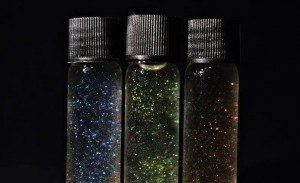Life is full of shiny packaging, cosmetic bottles, fruit bowls and more, but many of them are made of toxic and unsustainable materials that contribute to plastic pollution.
Recently, researchers at the University of Cambridge in the UK have found a way to create sustainable, non-toxic and biodegradable glitter from cellulose, the main building block of the cell walls of plants, fruits and vegetables. Related papers were published in the journal Nature Materials on the 11th.
Made from cellulose nanocrystals, this glitter uses structural color to alter light to produce vibrant colors. In nature, for example, the flashes of butterfly wings and peacock feathers are masterpieces of structural color, which will not fade after a century.
Using self-assembly techniques, cellulose can produce brightly colored films, the researchers say. By optimizing the cellulose solution and coating parameters, the research team was able to fully control the self-assembly process, allowing the material to be mass-produced in rolls. Their process is compatible with existing industrial-scale machines. Using commercially available cellulosic materials, it takes only a few steps to convert to a suspension containing this glitter.
After producing the cellulose films on a large scale, the researchers ground them into particles the size of which are used to make glitter or effect pigments. The pellets are biodegradable, plastic-free, and non-toxic. Furthermore, the process is much less energy-intensive than conventional methods.
Their material could be used to replace plastic glitter particles and tiny mineral pigments widely used in cosmetics. Traditional pigments, such as the glitter powders used in everyday use, are unsustainable materials and pollute the soil and oceans. Generally, pigment minerals must be heated at a high temperature of 800°C to form pigment particles, which is also not conducive to the natural environment.
The cellulose nanocrystal film prepared by the team can be manufactured on a large scale using a “roll-to-roll” process, just like paper is made from wood pulp, making this material industrial for the first time.
In Europe, the cosmetics industry uses about 5,500 tons of microplastics every year. Senior author of the paper, Professor Silvia Vignolini, from the Yusuf Hamid Department of Chemistry at the University of Cambridge, said they believed the product could revolutionize the cosmetics industry.
Post time: Nov-22-2022




